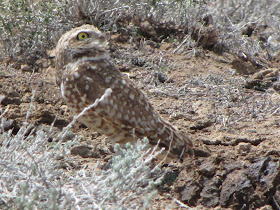
Why is it called a "burrowing" owl, you ask?

The photograph above says it all; Burrowing Owls nest and roost underground in burrows. Be sure to take a look at the top right portion of this photo, where you can see the approximately 8 inch tall Burrowing Owl perched above his burrow. Although Burrowing Owls are capable of digging their own burrows, they more often use burrows initially created by prairie dogs, ground squirrels, badgers, etc. They even find artificial structures, such as culverts, pipes, or burrows intentionally created by humans for Burrowing Owl use inhabitable. In fact, given the choice of an artificial burrow or a natural burrow, Burrowing Owls apparently often choose the manmade structure.

Even though they are able to use artifical structures as burrows, and even though they can withstand disturbance (see Jim McCormac's post on the Burrowing Owls in Cape Coral, Florida), Burrowing Owl populations are unfortunately declining. According to a source from California, the plummeting populations are due to several factors, including habitat loss and fragmentation, removal of rodents that create burrows later used by Burrowing Owls, burrow destruction, pesticide use, predation by non-native species, vehicle strikes, collisions with wind turbines, and shooting; in addition, many states allow "passive relocation" of the owls, but without creation of adequate artificial burrows there is no guarantee that relocated owls will survive (http://www.physorg.com/news204388626.html).

Burrowing Owls are very attentive and alert, but they blend in to their environment so well and stay so still that they can easily be overlooked or mistaken for a clump of dirt. While in Nevada, Brad Woodward and I watched a Burrowing Owl nonstop from 6:30 am to 7:00 pm one day. During that time, it only left its perch for 20 minutes, when it flew to its burrow as a Swainson's Hawk flew by. The only other movement we noticed was turning its head and ejecting a couple of pellets.

In addition to its small size, bright yellow eyes, white eyebrows, and white chin patch, Burrowing Owls have long legs and large feet, as seen in the two photographs below. They also lack ear tufts and are spotted on the back and barred on the front. These characteristics coupled with the habit of being perched on the ground are all you need to know you are looking at a Burrowing Owl.

You know what they say about owls with big feet, don't you?

One Native American tribe believed that Burrowing Owls were protective spirits for brave warriors, and their feathers were worn by warriors to frighten their enemies. You may think, "who would be afraid of this tiny, cute little owl..."

... after seeing the photograph above, I can see why this tribe thought their enemies would be frightened by feathers from a Burrowing Owl!
Great posts from Nevada, Scott! What do they say about owls with big feet? Does this owl let you walk right up to it?
ReplyDeleteWell... that they need big shoes, of course...
ReplyDeleteYes, Burrowing Owls will let you get very close. Jim McCormac posted on his blog about a population in Florida where he was able to get within 10 feet of the owls. We didn't get quite that close, but pretty close nonetheless.
beautiful! just beautiful.
ReplyDeleteThanks En Route... they are magnificent birds.
ReplyDelete